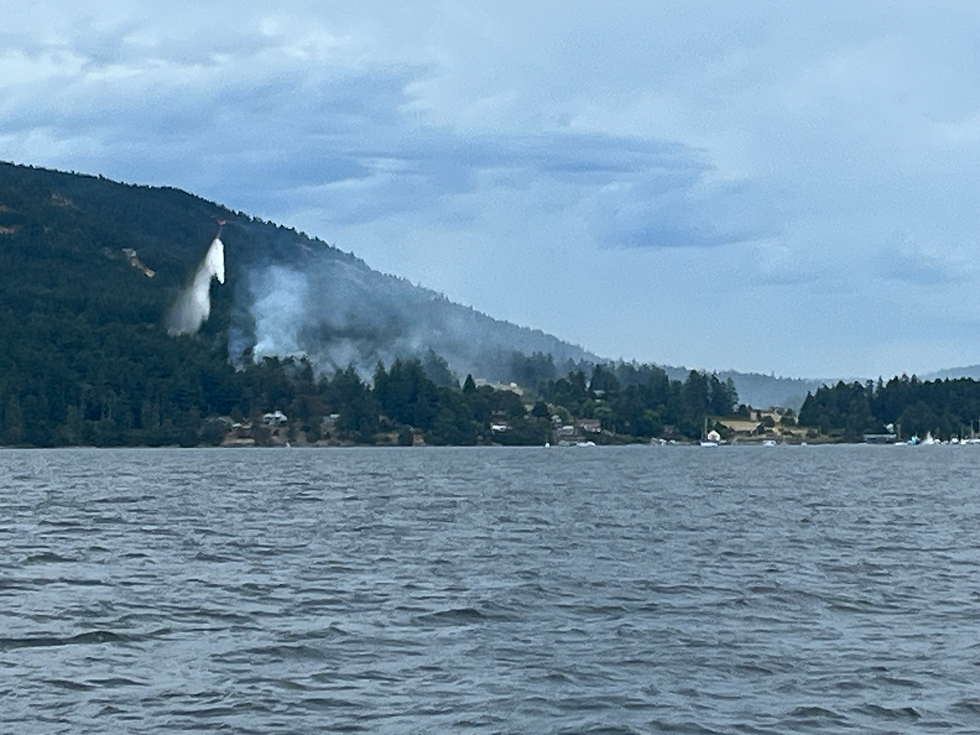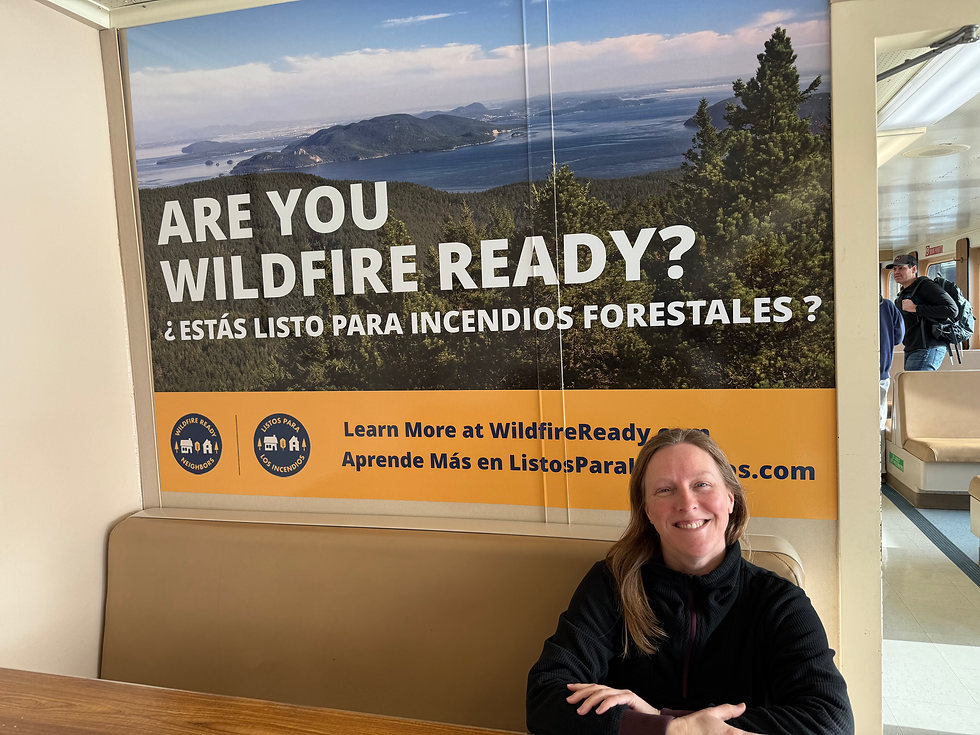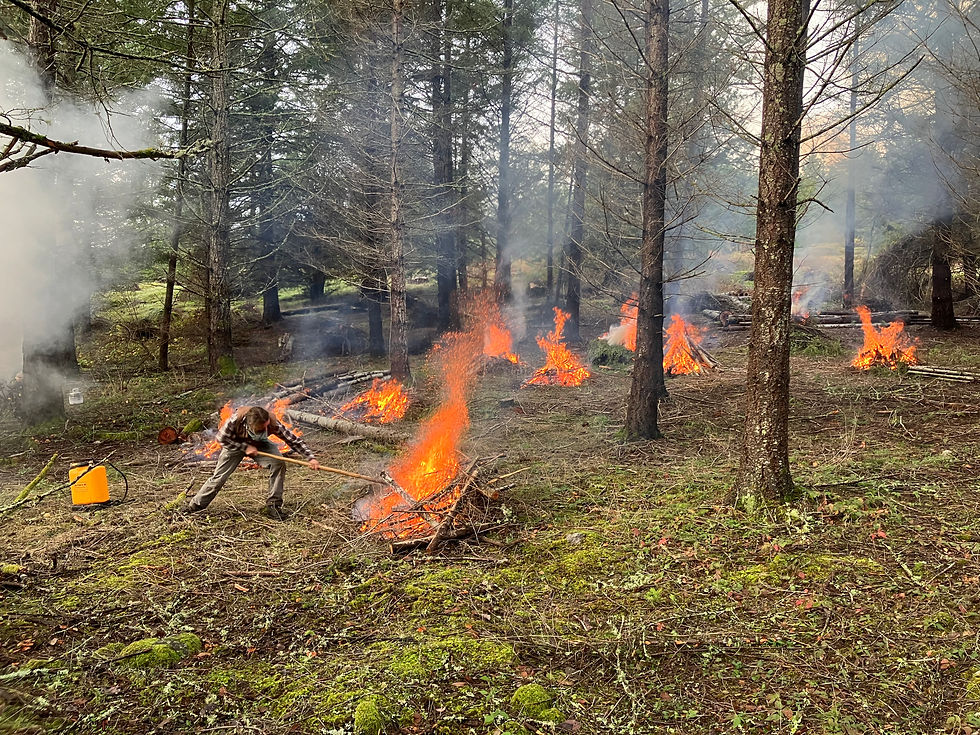Forestry Newsletter: August 2025
- SJICD
- Aug 7
- 7 min read
Updated: Aug 11
Hello and welcome to our summer edition!
This issue of the SJICD Forestry Newsletter features a variety of timely and interesting topics. Read on to learn more about:
Recent wildfires and actions you can take to lower wildfire risk
What’s next: Community Wildfire Protection Plan (CWPP)
Islands Conservation Corps wraps up another year of restoration work
Everyone benefits from a healthy forest- check out our new video!
Forestry funding outlook
Contractor list
Upcoming events

Wildfire Season is Here
As we move into August, the signs of wildfire season are all around us: dry grass, warm temperatures, and low humidity. Since early June, five wildfires have occurred on Orcas Island alone, serving as a sobering reminder of how quickly fire can ignite and spread in these conditions.
At least two—and possibly three—of these fires were caused by campfires, one started from a hot muffler, and another remains unknown.
With fire risk climbing, San Juan County raised its fire danger level to VERY HIGH on July 21. As a result, in addition to the burn permit suspension that began June 16, all recreational fires, including campfires and charcoal grills, are now prohibited.
Please do your part to help prevent wildfire—stay informed, follow local restrictions, and take extra care when working or recreating outdoors. For the most up to date information on burn bans and permits, monitor the San Juan County Fire Marshal’s web page.
An Ounce of Prevention
Most wildfires in San Juan County are caused by human activities, so prevention starts with all of us. It is important to be aware of activities that have the potential to cause an ignition. Here are a few tips to help us all be more careful:
Check burning restrictions and only light campfires when it’s safe and permitted. Note: campfires are currently banned due to high fire danger
Extinguish campfires completely (i.e., cool to the touch) before you leave.
Residential and commercial burn permits are required for any outdoor burning that isn’t a campfire; follow conditions of the permit closely
Make sure gas-powered equipment has spark arrestors
Use gas-powered equipment early in the day when fire risk is lower
Avoid rocks and other solid objects that could cause a spark if a metal blade strikes them
Consider switching to battery-powered equipment
Store fuel in approved, sealed containers away from sunlight, heat, and ignition sources
Avoid parking or driving on dry grass
Avoid a vehicle’s or other equipment’s hot exhaust system touching dry grass
On hot, dry, and/or windy days, consider putting off mowing or other outdoor equipment use

Protect Your Home from Wildfire
While preventing ignitions is essential, it’s just as important to prepare your home before a wildfire occurs. Research shows that hardening your home and creating defensible space within 100 feet of structures significantly increases the chances of your home surviving a wildfire.
Not sure where to start?
Schedule a free Wildfire Ready Neighbors home visit to receive a personalized report with clear, actionable steps to reduce your home’s wildfire risk. Over the past 16 months, SJICD and local fire districts have conducted hundreds of these assessments for homeowners throughout the islands. Sign up today!
Want to take it further with your community?
Join the Firewise USA® recognition program to work together on neighborhood-wide preparedness—and become eligible for annual Firewise Microgrants from Washington DNR to help fund improvements.
What’s Next: Community Wildfire Protection Plan (CWPP)
Thanks to all who participated in the CWPP planning process. The final plan has been approved by Washington DNR, which means that we are shifting from planning to action.
The CWPP serves as a roadmap for communities to proactively reduce wildfire risk through collaborative efforts, prioritizing fuel reduction, promoting structural protection measures, and preparing for potential wildfire events.
An important next step is applying for grants that can fund some of this work; these opportunities are limited right now but we are hopeful that more are on the horizon.

Islands Conservation Corps Wraps Up Another Year of Restoration Work
The Islands Conservation Corps (ICC), a field restoration program of the San Juan Islands Conservation District, completed its 5th year of forest restoration work. This past year the team of 15 members conducted thinning, burning, and/or shaded fuel breaks on a large number of sites including Mt. Grant Preserve, Mitchell Hill Preserve, Turtleback Mountain preserve, Jones Island, Moran State Park, Cady Mountain Preserve, West Side Preserve, and Waldron Island. Beyond a successful and safe year of activities, the ICC conducted its first prescribed fire on Mt. Grant under the guidance of Sami Schinnell, the former Washington State Burn Boss for the Nature Conservancy and current chair of the Washington State Prescribed Fire Council. The burn was conducted in a safe and controlled manner, working to reduce fine fuels for wildfire risk and open planting space for native species. The ICC is grateful for the support of Sami Schinnell, the WA Department of Natural Resources, and San Juan Fire for their support in this successful project.
Spotlight: Islands Conservation Corps at The Farm at Krystal Acres
If you drove by The Farm at Krystal Acres last winter or spring, you may have noticed our Islands Conservation Corps Crew in action. We’re partnering with the property owners to establish a new forested landscape through afforestation—introducing nearly 300 Garry oak trees and over 1,200 other native species to improve biodiversity, restore native plant communities, and support carbon sequestration. Protective cages have been installed to shield the saplings from deer browsing, ensuring successful growth. This exciting project showcases the long-term benefits of afforestation efforts! We’ll share more as the project continues.
Everyone Benefits from a Healthy Forest:
Check Out Our New Video!
Forests play a vital role in our lives and ecosystems—cleaning our air, regulating water, storing carbon, supporting wildlife, and providing food, timber, recreation, and cultural value. Their importance spans the globe, and here in San Juan County, we’re doing our part to care for them.
This spring, we partnered with Free Road Films to create a beautiful short video highlighting some of the forest health work happening across the county.
Watch the video and see the work in action.
Forestry Funding Outlook
As of July 1, the new state biennium has begun—and with it, forestry funding has been drastically cut. Conservation districts and Washington DNR are now working with a smaller pool of resources than in past years while wildfire risk is on the rise. If you are concerned about these funding cuts, we encourage you to reach out to your local legislators today to let them know that local forestry funding is essential.
Despite these changes, we remain committed to serving all San Juan County residents and landowners. While cost share programs are currently limited, we are still offering free technical assistance and forest stewardship planning.
We’re actively pursuing new grants to bring back cost share opportunities as soon as possible. If you’re interested in participating when funding becomes available, we encourage you to join our waitlist. A strong waitlist helps demonstrate to decision makers that this support is needed and valued in our community.
To sign up or learn more, contact Cathi at cathi@sjicd.org.
Need a contractor?
Have you received recommendations from the Conservation District, but are struggling to find someone to complete the work? We’ve compiled a list of service providers available for recommended projects. Browse the list here. If you’re a contractor or know someone who should be included, please complete this survey.
Upcoming Events
Friday, August 8: Reducing Wildfire Risk in San Juan Forests
Join SJICD’s Kai Hoffman-Krull, Carson Sprenger from Rain Shadow Consulting, and Kirk Hanson from Northwest Natural Resource Group, for this field workshop that explores strategies to increase forest resilience through ecological forestry practices. 9:30 am – 3:30 pm on Orcas Island. Register
August 14-17th: See you at the Fair!
Look for our booth in the Green Village.
September 25 and 26: Visit with a Wildlife Biologist
Interested in learning more about managing your forest for wildlife? Ken Bevis, Stewardship Wildlife Biologist for Washington DNR, will be at the Field Day event described below. He has also offered to come early and make site visits on 9/25 and 9/26. If there is enough interest we can schedule some one-on-one visits! Contact cathi@sjicd.org for more information.
Saturday, September 27: 2025 San Juan Islands Forest Owner’s Field Day
The Field Day is a full day of workshops on San Juan Island that cover a wide variety of topics in a family-friendly, out-in-the-woods environment. Learn how to foster healthy and resilient forest conditions in your woods, address common challenges, pursue new stewardship opportunities, and achieve your goals for your property. Brought to you by WSU Puget Sound Extension Forestry. More details will be coming soon.
Mid-August: Join the Conversation - Forest Biomass to Energy Assessment
WSU and Pacific Northwest National Labs are conducting a U.S. Department of Energy-funded assessment on forest biomass supply for biofuel production in the Pacific Northwest. We’re seeking input from landowners, professionals, agencies, Tribes, and the broader forest community to better understand opportunities and challenges in supplying biomass for energy.
Virtual Listening Sessions:
Forest Landowners: Aug 11 (1:30–3 pm), Aug 18 (11 am–12:30 pm)
Forest Professionals: Aug 11 (8–9:30 am), Aug 12 (8–9:30 am)
Agency/Tribal: Aug 13 (8–9:30 am)
Open to All: Aug 14 (10:30 am–12 pm)
Questions? Contact Francesca Pierobon at francesca.pierobon@pnnl.gov
The San Juan Islands Conservation District Forest Stewardship Program is supported with funding from Washington’s Climate Commitment Act. The CCA puts cap-and-invest dollars to work reducing climate pollution, creating jobs, and improving public health. Information about the CCA is available at www.climate.wa.gov.
Funded wholly or in part by the EPA Puget Sound Recovery National Program under grant #PC-01J89501





Comments